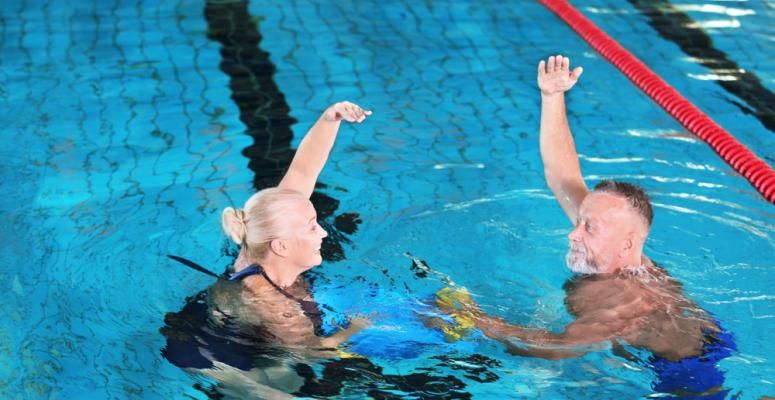
Swimming has many health benefits. It's shown to lower blood pressure and regulate blood sugar, both which can contribute to long-term health. Swimming can also be a good form of exercise for people who can't participate in high-impact workouts like running. It allows people with arthritis or healing injuries to exercise without gravity putting pressure on the joints. That's why many physical therapists include aquatic therapy in their treatment plans ” it can be a more effective and pain-free form of treatment for certain types of patients. While slightly different from traditional swimming, there are many benefits to aquatic therapy, which we'll discuss in this article.
What is aquatic therapy?
Aquatic therapy is a type of physical therapy performed in water. It is used to provide pain relief for people recovering from injuries or struggling with certain musculoskeletal disorders. The water of the pool gives the patient some resistance to work against, which can be helpful for building muscles. However, the patient is relieved of the impact often involved in land physical therapy, which can help them to avoid further pain. Aquatic therapy is different from swimming in that the swimming pool used for therapy may be quite small or shallow. In some cases, patients may not even need to know how to swim in order to undergo this form of treatment. Sessions typically last from 30 to 60 minutes, although exact session timelines may vary from clinic to clinic.
Who can benefit from aquatic therapy?
Aquatic therapy is used to treat many different conditions, including:
- Sports injuries.
- Ankle sprains.
- Knee injuries.
- Arthritis (all forms).
- Fibromyalgia.
- Balance disorders.
- Post-surgery rehabilitation.
- Neurological disorders.
- Movement disorders related to traumatic brain injuries.
- Chronic pain in all parts of the body.
These are just a few examples. Your physical therapist may recommend aquatic therapy for a number of other conditions as well. If you're curious about this form of treatment and your clinic offers it, ask if it might be effective for your condition or injury. Note: There are some aquatic therapy contraindications that can prevent you from participating in this form of treatment.
Benefits of aquatic therapy
Aquatic therapy offers many benefits. Here are just a few examples:
- Low-impact exercise ” Standing on a hard floor (even with a mat) places added pressure on the joints in the lower extremities. Aquatic therapy eliminates this pressure, allowing patients to build muscle and flexibility while avoiding joint strain.
- Promoting muscle repair ” Some aquatic therapy sessions take place in warm water. Like a warm bath, this increases blood flow, which brings more oxygen and nutrients to any injured or achy muscles.
- Providing balance ” Aquatic therapy provides full support for the body, removing the risk of falling. For this reason, it often benefits people with a high fall risk due to balance disorders.
- Offering cardiovascular benefits ” Water compresses your body when you submerge yourself in it, which causes your lungs and heart to work harder to pump blood. This can strengthen your cardiovascular system.
- Soothing achy muscles ” Increased blood flow to the muscles loosens them up and makes the connective tissue more elastic. This helps relieve muscle pain.
- Friendly to (almost) all ages ” Aquatic therapy is open to people of all ages, from young children to older people.
- Sweat-free exercise ” One more benefit to aquatic therapy is that patients are able to perform their exercises without breaking a sweat, making it a comfortable and convenient activity to work into their daily routine.
In addition to the aquatic therapy benefits listed above, you may be able to perform your exercises outside of your sessions if you have access to a swimming pool. Your physical therapist will walk you through the exercises during your session at the clinic, and you can perform them at the public pool or in your backyard.
What kinds of exercises do you do in aquatic therapy?
Here are a few of the exercises your physical therapist might walk you through during your aquatic therapy sessions:
- Balancing on one leg ” Standing on one leg in a pool can be an effective form of balance training if you are at a high risk of falling on land. Your physical therapist may have you hold the side of the pool or a float until you can balance without aid.
- Water walking ” Walking forward and backward in the pool is a simple way to walk with resistance. Your therapist may have you hold a kickboard or foam pool noodle to increase resistance further.
- Bicycle kicks ” This exercise can help to build muscle in your legs. Your physical therapist will have you hold a pool noodle and kick continuously for three to five minutes (or until you're tired).
There are many other aquatic exercises used for physical therapy. When you visit a physical therapist, they will determine which ones are right for your treatment.
Alliance PTP is ready to help you find top-notch aquatic therapy
At Alliance Physical Therapy Partners, we're proudly bringing together physical therapy practices across the country to help people get the high-quality PT they need. Want to see a physical therapist in person? We can put you in touch with an Alliance PTP partner that's close to you and that can provide aquatic therapy treatment. Not keen on in-person PT sessions or not close to an Alliance PTP partner? No worries. We also offer effective and affordable virtual physical therapy through our Agile Virtual Physical Therapy platform. Contact our team today so we can help you find the most effective physical therapy services for your injury or condition.
Get Help at a Location Near You
